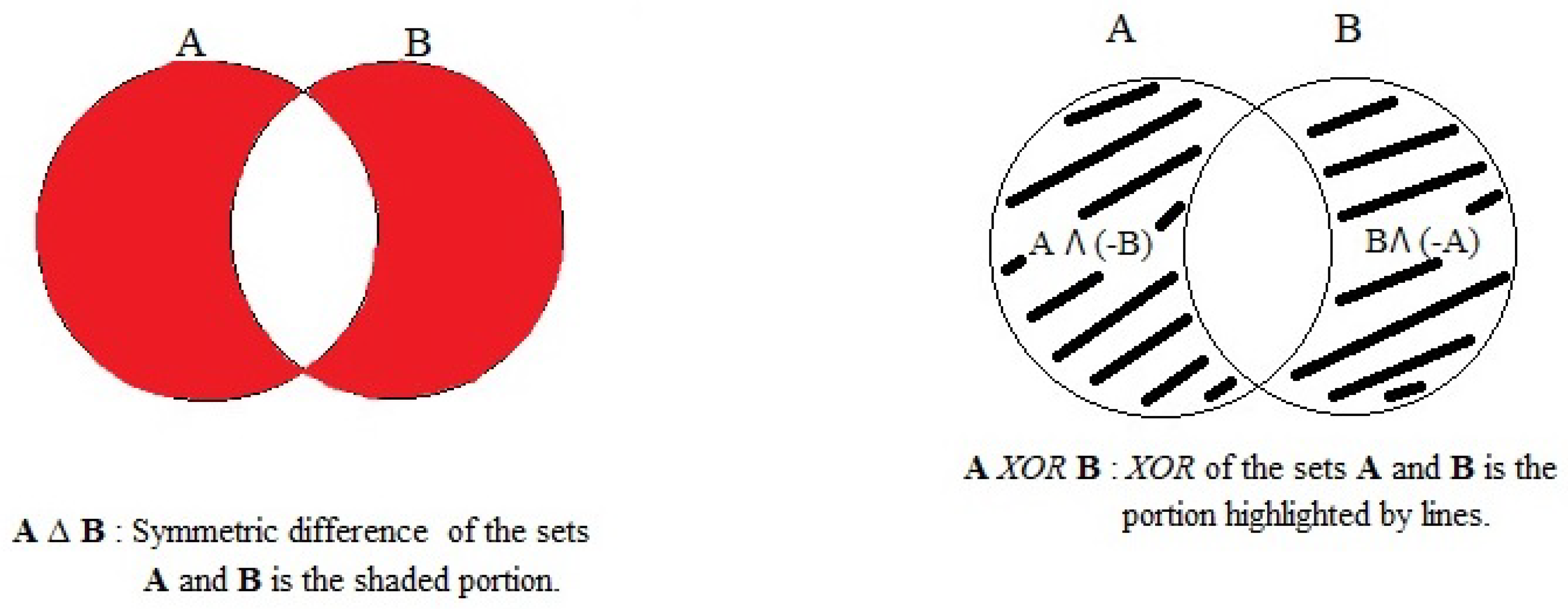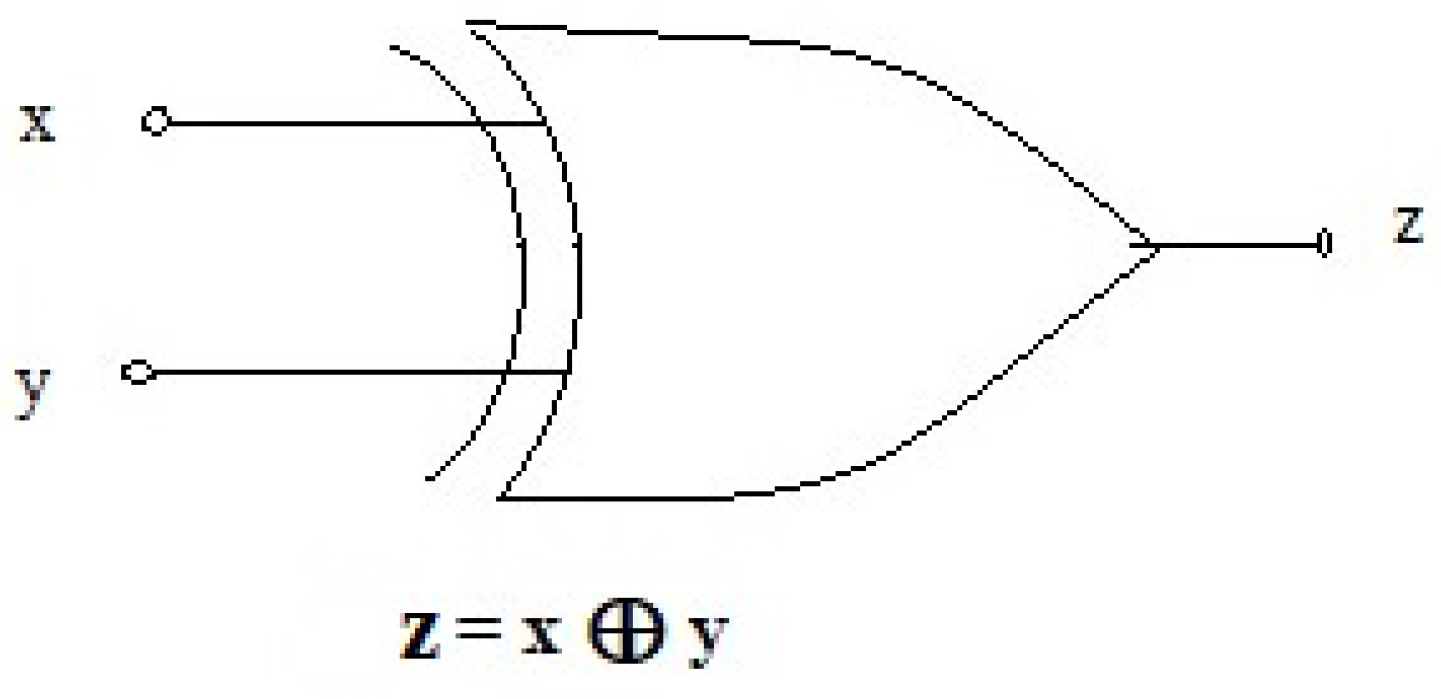Sensitivity Analysis of Mixed Cayley Inclusion Problem with XOR-Operation
Abstract
1. Introduction
2. Preliminaries
- (i)
- (ii)
- (iii)
- (iv)
- (i)
- (ii)
- if then
- (iii)
- (iv)
- if
- (v)
- if then , if and only if
- (vi)
- (vii)
- (viii)
- if then
- (i)
- A is said to be a comparison mapping if then , , and , for all ;
- (ii)
- A is said to be strongly comparison mapping if A is a comparison mapping and , if and only if , ;
- (iii)
- M is said to be a comparison mapping if, for any and if then for any ;
- (iv)
- M is said to be weak comparison mapping if, for any , , then there exists and such that , , and ;
- (v)
- a comparison mapping M is said to be γ-ordered rectangular if there exists a constant and, for any , there exists and such that
- (vi)
- M is said to be λ-weak-ordered different comparison mapping if there exists a constant such that for any , there exists and such that ;
- (vii)
- a weak comparison mapping M is said to be a -weak-ordered rectangular different multivalued mapping, if M is a γ-ordered rectangular and ρ-weak-ordered different comparison mapping and , for .
- (i)
- strongly monotone, if there exists a constant such that
- (ii)
- Lipschitz continuous, if there exists a constant such that
- (iii)
- relaxed Lipschitz continuous, if there exists a constant such that
3. Formulation of the Problem
4. Sensitivity Analysis
- (1)
- The mapping T is relaxed Lipschitz continuous, Lipschitz continuous with respect to first argument, and continuous with respect to second argument.
- (i)
- that is, is -relaxed Lipschitz continuous with respect to the first argument.
- (ii)
- that is, is -Lipschitz continuous with respect to the first argument.
- (iii)
- that is, is continuous with respect to the second argument.
- (2)
- The mapping g is Lipschitz continuous.that is, is -Lipschitz continuous.
- (3)
- In order to show that the mapping M is ordered rectangular mapping, let and , we evaluateThus, M is -ordered rectangular mapping.
- (4)
- Now, we will show that the solution of the parametric resolvent equation with XOR-operation (10) is continuous (or Lipschitz continuous). We take and evaluate implicit resolvent operator as well as the implicit Cayley operator asand
5. Conclusions
Author Contributions
Funding
Acknowledgments
Conflicts of Interest
References
- Qin, X.; Yao, J.C. A viscosity iterative method for a split feasibility problem. J. Nonlinear Convex Anal. 2019, 20, 1497–1506. [Google Scholar]
- An, N.T.; Nam, N.M. Solving k-center problems involving sets based on optimization techniques. J. Glob. Optim. 2019. [Google Scholar] [CrossRef]
- Cho, S.Y.; Qin, X. On the strong convergence of an iterative process for asymptotically strict pseudocontractions and equilibrium problems. Appl. Math. Comput. 2014, 235, 430–438. [Google Scholar] [CrossRef]
- Qin, X.; An, N.T. Smoothing algorithms for computing the projection onto a Minkowski sum of convex sets. Comput. Optim. Appl. 2019. [Google Scholar] [CrossRef]
- Takahahsi, W.; Yao, J.C. The split common fixed point problem for two finite families of nonlinear mappings in Hilbert spaces. J. Nonlinear Convex Anal. 2019, 20, 173–195. [Google Scholar]
- Takahashi, W.; Wen, C.F.; Yao, J.C. The shrinking projection method for a finite family of demimetric mappings with variational inequality problems in a Hilbert space. Fixed Point Theory 2018, 19, 407–419. [Google Scholar] [CrossRef]
- Cho, S.Y.; Kang, S.M. Approximation of common solutions of variational inequalities via strict pseudocontractions. Acta Math. Sci. 2012, 32, 1607–1618. [Google Scholar] [CrossRef]
- Chang, S.S.; Wen, C.F.; Yao, J.C. Zero point problem of accretive operators in Banach spaces. Bull. Malays. Math. Sci. Soc. 2019, 42, 105–118. [Google Scholar] [CrossRef]
- Chang, S.S.; Wen, C.F.; Yao, J.C. Common zero point for a finite family of inclusion problems of accretive mappings in Banach spaces. Optimization 2018, 67, 1183–1196. [Google Scholar] [CrossRef]
- Qin, X.; Cho, S.Y. Convergence analysis of a monotone projection algorithm in reflexive Banach spaces. Acta Math. Sci. 2017, 37, 488–502. [Google Scholar] [CrossRef]
- Kimura, Y.; Nakajo, K. Strong convergence for a modified forward-backward splitting method in Banach spaces. J. Nonlinear Var. Anal. 2019, 3, 5–18. [Google Scholar]
- Yang, Y.; Yuan, Q. A hybrid descent iterative algorithm for a split inclusion problem. J. Nonlinear Funct. Anal. 2018, 42. [Google Scholar]
- Qin, X.; Cho, S.Y.; Wang, L. A regularization method for treating zero points of the sum of two monotone operators. Fixed Point Theory Appl. 2014, 75. [Google Scholar] [CrossRef]
- Gibali, A.; Ha, N.H.; Thuong, N.T.; Trang, T.H.; Vinh, N.T. Polyak’s gradient method for solving the split convex feasibility problem and its applications. J. Appl. Numer. Optim. 2019, 1, 145–156. [Google Scholar]
- Husain, S.; Singh, N. A hybrid iterative algorithm for a split mixed equilibrium problem and a hierarchical fixed point problem. Appl. Set-Valued Anal. Optim. 2019, 1, 149–169. [Google Scholar]
- Qin, X.; Cho, S.Y.; Wang, L. Iterative algorithms with errors for zero points of m-accretive operators. Fixed Point Theory Appl. 2013, 148. [Google Scholar] [CrossRef]
- Cho, S.Y. Strong convergence analysis of a hybrid algorithm for nonlinear operators in a Banach space. J. Appl. Anal. Comput. 2018, 8, 19–31. [Google Scholar]
- Ahmad, I.; Pang, C.T.; Ahmad, R.; Ishtyak, M. System of Yosida inclusions involving XOR-operation. J. Nonlinear Convex Anal. 2017, 18, 831–845. [Google Scholar]
- Ahmad, I.; Rahaman, M.; Ahmad, R.; Ali, I. Convergence analysis and stability of perturbed three-step iterative algorithm for generalized mixed order quasi-variational inclusion involving XOR-operation. Optimization 2019. [Google Scholar] [CrossRef]
- Bin Dehaish, B.A. Weak and strong convergence of algorithms for the sum of two accretive operators with applications. J. Nonlinear Convex Anal. 2015, 16, 1321–1336. [Google Scholar]
- Qin, X.; Cho, S.Y.; Yao, J.C. Weak and strong convergence of splitting algorithms in Banach spaces. Optimization 2019. [Google Scholar] [CrossRef]
- Ali, I.; Ahmad, R.; Wen, C.F. Cayley Inclusion Problem Involving XOR-operation. Mathematics 2019, 7, 302. [Google Scholar] [CrossRef]
- Zamir, M.; Zaman, G.; Alshomrani, A.S. Sensitivity analysis and optimal control of anthroponotic cutaneous leishmania. PLoS ONE 2011, 11, e0160513. [Google Scholar] [CrossRef]
- Schnelle, S.; Wang, J. Sensitivity analysis of human driving characteristics on road and driving conditions for active vehicle control systems. IEEE Int. Conf. Syst. Man Cybern. SMC 2014. [Google Scholar] [CrossRef]
- Tchuenche, J.M.; Khamis, S.A.; Agusto, F.B.; Mpeshe, S.C. Optimal control and sensitivity analysis of an influenza model with treatment and vaccination. Acta Biotheor. 2011, 59, 1–28. [Google Scholar] [CrossRef]
- Rodrigues, H.S.; Monteiro, M.T.T.; Torres, D.F.M. Sensitivity analysis in a dengue epidemiological model. Conf. Pap. Math. 2013, 721406. [Google Scholar] [CrossRef]
- Tobin, R.L. Sensitivity analysis for variational inequalities. J. Optim. Theory Appl. 1986, 48, 191–204. [Google Scholar] [CrossRef]
- Kyparisis, J. Sensitivity analysis framework for variational inequalities. Math. Program. 1987, 38, 203–213. [Google Scholar] [CrossRef]
- Kyparisis, J. Sensitivity analysis for variational inequalities and nonlinear complementarity problems. Ann. Oper. Res. 1990, 27, 143–173. [Google Scholar] [CrossRef]
- Dafermos, S. Sensitivity analysis in variational inequalities. Math. Oper. Res. 1988, 13, 421–434. [Google Scholar] [CrossRef]
- Qui, Y.; Magnanti, T.L. Sensitivity analysis for variational inequalities defined on polyhedral sets. Math. Oper. Res. 1989, 14, 410–432. [Google Scholar]
- Li, H.G.; Li, L.P.; Zheng, J.M.; Jin, M.M. Sensitivity analysis for generalized set-valued parametric ordered variational inclusion with (α,λ)-NODSM mappings in ordered Banach spaces. Fixed Point Theory Appl. 2014, 2014, 122. [Google Scholar] [CrossRef][Green Version]
- Yen, N.D.; Lee, G.M. Solution sensitivity of a class of variational inequalities. J. Math. Anal. Appl. 1997, 215, 48–55. [Google Scholar] [CrossRef]
- Agarwal, R.P.; Huang, N.J.; Tan, M.Y. Sensitivity analysis for a new system of generalized nonlinear mixed quasi-variational inclusions. Appl. Math. Lett. 2004, 17, 345–352. [Google Scholar] [CrossRef]
- Hsu, F.K.; Bahill, A.T.; Stark, L. Parametric sensitivity analysis of a homeomorphic model for saccadic and vergence eye movements. Comput. Programs Biomed. 1976, 6, 108–116. [Google Scholar] [CrossRef]
- Martínez-García, M.; Zhang, Y.; Gordon, T. Modeling Lane Keeping by a Hybrid Open-Closed-Loop Pulse Control Scheme. IEEE Trans. Ind. Inform. 2016, 12, 2256–2265. [Google Scholar] [CrossRef]
- Du, Y.H. Fixed points of increasing operators in ordered Banach spaces and applications. Appl. Anal. 1990, 38, 1–20. [Google Scholar] [CrossRef]
- Qin, X.; Petrusel, A.; Yao, J.C. CQ iterative algorithms for fixed points of nonexpansive mappings and split feasibility problems in Hilbert spaces. J. Nonlinear Convex Anal. 2018, 19, 157–165. [Google Scholar]
- Zhao, X. Linear regularity and linear convergence of projection-based methods for solving convex feasibility problems. Appl. Math. Optim. 2018, 78, 613–641. [Google Scholar] [CrossRef]
- Ogbuisi, F.U. Popov subgradient extragradient algorithm for pseudomonotone equilibrium problems in Banach spaces. J. Nonlinear Funct. Anal. 2019, 2019, 44. [Google Scholar]
- Ceng, L.C.; Petrusel, A.; Yao, J.C.; Yao, Y. Systems of variational inequalities with hierarchical variational inequality constraints for Lipschitzian pseudocontractions. Fixed Point Theory 2019, 20, 113–134. [Google Scholar] [CrossRef]


© 2020 by the authors. Licensee MDPI, Basel, Switzerland. This article is an open access article distributed under the terms and conditions of the Creative Commons Attribution (CC BY) license (http://creativecommons.org/licenses/by/4.0/).
Share and Cite
Ali, I.; Ishtyak, M.; Ahmad, R.; Wen, C.-F. Sensitivity Analysis of Mixed Cayley Inclusion Problem with XOR-Operation. Symmetry 2020, 12, 220. https://doi.org/10.3390/sym12020220
Ali I, Ishtyak M, Ahmad R, Wen C-F. Sensitivity Analysis of Mixed Cayley Inclusion Problem with XOR-Operation. Symmetry. 2020; 12(2):220. https://doi.org/10.3390/sym12020220
Chicago/Turabian StyleAli, Imran, Mohd. Ishtyak, Rais Ahmad, and Ching-Feng Wen. 2020. "Sensitivity Analysis of Mixed Cayley Inclusion Problem with XOR-Operation" Symmetry 12, no. 2: 220. https://doi.org/10.3390/sym12020220
APA StyleAli, I., Ishtyak, M., Ahmad, R., & Wen, C.-F. (2020). Sensitivity Analysis of Mixed Cayley Inclusion Problem with XOR-Operation. Symmetry, 12(2), 220. https://doi.org/10.3390/sym12020220




